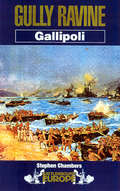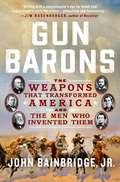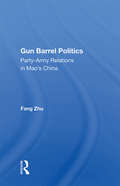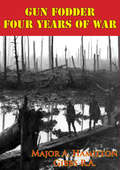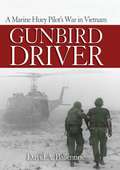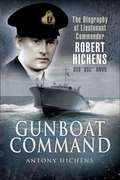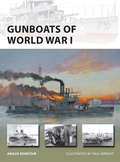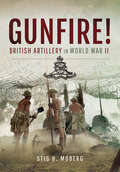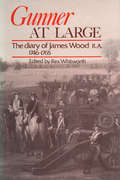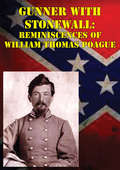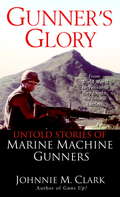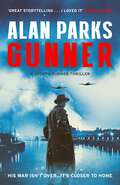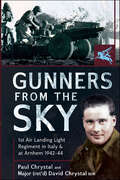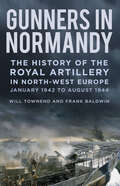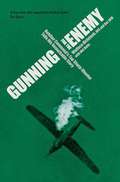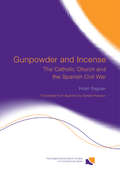- Table View
- List View
Gulf War and Health: Update of Health Effects of Serving in the Gulf War, 2016
by Engineering Medicine National Academies of SciencesFor the United States, the 1991 Persian Gulf War was a brief and successful military operation with few injuries and deaths. However, soon after returning from duty, a large number of veterans began reporting health problems they believed were associated with their service in the Gulf. At the request of Congress, the Institute of Medicine (IOM) has been conducting an ongoing review of the evidence to determine veterans' long-term health problems and potential causes. The fourth volume in the series, released in 2006, summarizes the long-term health problems seen in Gulf War veterans. In 2010, the IOM released an update that focuses on existing health problems and identifies possible new ones, considering evidence collected since the initial summary. Gulf War and Health: Volume 10, the final volume of the series, is an update of the scientific and medical literature on the health effects associated with deployment to the Gulf War that were identified in Volumes 4 and 8. This report reviews and evaluates the associations between illness and exposure to toxic agents, environmental or wartime hazards, or preventive measures and vaccines associated with Gulf War service, and provides recommendations for future research efforts on Gulf War veterans.
Gulf War and Health: Updated Literature Review of Sarin
by Committee on Gulf WarThe Gulf War in 1990-1991 was considered a brief and successful military operation, with few injuries or deaths of US troops. The war began in August 1990, and the last US ground troops returned home by June 1991. Although most Gulf War veterans resumed their normal activities, many soon began reporting a variety of nonexplained health problems that they attributed to their participation in the Gulf War, including chronic fatigue, muscle and joint pain, loss of concentration, forgetfulness, headache, and rash. Because of concerns about the veterans' health problems, the Department of Veterans Affairs (VA) requested that the Institute of Medicine (IOM) review the scientific and medical literature on the long-term adverse health effects of agents to which the Gulf War veterans may have been exposed. This report is a broad overview of the toxicology of sarin and cyclosarin. It assesses the biologic plausibility with respect to the compounds in question and health effects.
Gulf War and Health: Volume 1. Depleted Uranium, Sarin, Pyridostigmine Bromide, Vaccines
by Institute of MedicineMany combat troops who served in the Gulf War have suffered on-going health problems which may be linked to their wartime service. In response to the concerns of veterans and their families, the Department of Veterans Affairs contracted with the Institute of Medicine (IOM) to research possible connections between biological and chemical agents to which Gulf War veterans may have been exposed, and adverse health effects. This report presents findings from the first stage of the project, focusing on four agents: depleted uranium, pyridostigmine bromide, sarin, and vaccines. Reports on other agents will follow, in this long-term commitment to study all of the agents to which the veterans may have been exposed. Annotation c. Book News, Inc. , Portland, OR (booknews. com)
Gulf War and Health: Volume 11: Generational Health Effects Of Serving In The Gulf War
by Engineering Medicine National Academies of SciencesFor the United States, the 1991 Persian Gulf War was a brief and successful military operation with few injuries and deaths. However, soon after returning from duty, a large number of veterans began reporting health problems they believed were associated with their service in the Gulf. At the request of Congress, the National Academies of Sciences, Engineering, and Medicine has been conducting an ongoing review of the evidence to determine veterans' long-term health problems and potential causes. Some of the health effects identified by past reports include post-traumatic stress disorders, other mental health disorders, Gulf War illness, respiratory effects, and self-reported sexual dysfunction. Veterans’ concerns regarding the impacts of deployment-related exposures on their health have grown to include potential adverse effects on the health of their children and grandchildren. These concerns now increasingly involve female veterans, as more women join the military and are deployed to war zones and areas that pose potential hazards. Gulf War and Health: Volume 11 evaluates the scientific and medical literature on reproductive and developmental effects and health outcomes associated with Gulf War and Post-9/11 exposures, and designates research areas requiring further scientific study on potential health effects in the descendants of veterans of any era.
Gulf War and Health: Volume 2
by Committee on Gulf WarGulf War and Health, Volume 2, is the second in a series of congressionally-mandated studies by the Institute of Medicine that provides a comprehensive assessment of the available scientific literature on potential health effects of exposure to certain biological, chemical, and environmental agents associated with the Gulf War. In this second study, the committee evaluated the published, peer-reviewed literature on exposure to insecticides and solvents thought to have been present during the 1990-1991 war. Because little information exists on actual exposure levels - a critical factor when assessing health effects - the committee could not draw specific conclusions about the health problems of Gulf War veterans. However, the study found some evidence, although usually limited, to link specific long-term health outcomes with exposure to certain insecticides and solvents. The next phase of the series will examine the literature on potential health effects associated with exposure to selected environmental pollutants and particulates, such as oil-well fires and jet fuels.
Gully Ravine: Gallipoli (Battleground Europe)
by Stephen ChambersThis book concentrates on Gully Ravine and its immediate area on the western side of the Helles battlefield. Here trench fighting raged throughout the campaign, culminating in the Battle of Gully Ravine between 28 June and 5 July 1915. This attack was a successful piece of planning and execution, enabling the British to capture five lines of Turkish trenches, seriously threatening the Turkish hold on the southern tip of the peninsula. After this attack the region fell into the deadlock of trench warfare, which brought its horrors as well as its monotony. This beautiful and picturesque area of Gallipoli is seldom visited, and its part in the campaign almost forgotten. The book is well researched and contains a high proportion of original photographs and maps, which have never been published before.
Gun Barons: The Weapons That Transformed America and the Men Who Invented Them
by John Bainbridge Jr.John Bainbridge, Jr.'s Gun Barons is a narrative history of six charismatic and idiosyncratic men who changed the course of American history through the invention and refinement of repeating weapons.Love them or hate them, guns are woven deeply into the American soul. Names like Colt, Smith & Wesson, Winchester, and Remington are legendary. Yet few people are aware of the roles these men played at a crucial time in United States history, from westward expansion in the 1840s, through the Civil War, and into the dawn of the Gilded Age. Through personal drive and fueled by bloodshed, they helped propel the young country into the forefront of the world's industrial powers.Their creations helped save a nation divided, while planting seeds that would divide the country again a century later. Their inventions embodied an intoxicating thread of American individualism—part fiction, part reality—that remains the foundation of modern gun culture. They promoted guns not only for the soldier, but for the Everyman, and also made themselves wealthy beyond their most fevered dreams.Gun Barons captures how their bold inventiveness dwelled in the psyche of an entire people, not just in the minds of men who made firearm fortunes. Whether we revere these larger-than-life men or vilify them, they helped forge the American character.
Gun Barrel Politics: Party-army Relations In Mao's China
by Fang ZhuThis book tests the model of civil-military dualism to explain People's Liberation Army's (PLA) political engagement and its loyalty to the party in Maoist China. It explores how the party maintained its control— through penetration of the armed forces or non-intervention and civilian control.
Gun Fodder - Four Years Of War [Illustrated Edition]
by Major A. Hamilton Gibbs R.A.Includes the First World War Illustrations Pack - 73 battle plans and diagrams and 198 photosMemoirs of an officer, brother of the war correspondent, Philip Gibbs, who enlisted as a trooper in 9th Lancers, was commissioned into the Royal Artillery at the end of 1914, then served in Salonika and on the Western front.
Gun Shy: The True Story of the Army Dog Scared of War
by Alison Stokes Angie McDonellVidar, the army search dog, has spent half his life sniffing out enemy weapons and bombs on the front line of the war in Afghanistan. His keen nose saved the lives of hundreds of soldiers, finding roadside bombs which could have killed British troops. But after two years of loyal service, Vidar became ‘Gun Shy’ – a term used to describe dogs who are frightened of loud noises. Whenever he heard bombs exploding or even the sound of helicopters flying above, he would curl up in the corner, shaking with fear.His army days were numbered… and his future looked uncertain. Until Angie, an army medic who befriended him during her tour of Afghanistan, made it her duty to give him a safe haven at her Welsh home.
Gunbird Driver
by David A. BallentineGunbird Driver is a memoir of the Vietnam War as seen through the eyes of a young pilot flying an armed UH-1E's in Marine Observation Squadron 6. The book provides information about the missions, operations, and the living conditions at Ky Ha, and about the fellow Marines with whom he served. It also contains several chapters on shipboard operation from deployment aboard the USS Princeton. Parts of the book are deadly serious, even sad, as must be the case with any treatment of war; other parts are largely descriptive, and some circumstances and situations are even humorous. The time was 1966-67, relatively early in the war, the year before the Tet Offensive. The squadron's activities ranged widely in I Corps, the northern-most military subdivision of South Vietnam, the one assigned to the Marines. Although, the squadron and the air group to which it was attached (MAG -36) was assigned to the southern third of I Corps, it flew missions north along the DMZ, at Khe Sanh, west of Phu Bai and even into Laos, in addition to those in their local Tactical Area of Responsibility. Written to preserve a record of the impressions and experiences of one young 1st Lieutenant flying a Marine Huey in the war-torn skies of Vietnam, it is also reflective of all who crewed the UH-1E's - pilots, crew chiefs, and door gunners. It is a memoir that will resonate with all who crewed a "helo" in during the Vietnam war. No other book has been written on the Vietnam War from the perspective of a Marine Corps UH-1E pilot, flying armed escort missions for the Marines fighting the war on the ground.
Gunboat Command: The Biography of Lieutenant Commander Robert Hichens DSO* DSC** RNVR
by Antony HichensThis biography draws heavily on the personal diaries of the subject, Robert Hichens (or Hitch as he was universally known).After a brief description of his early life, time at Oxford, his motor racing achievements (including trophies at Le Mans in his Aston Martin) and RN training, the book focuses on his exceptional wartime experiences. Hitch was the most highly decorated RNVR officer of the war with two DSOs, three DSCs and three Mentions in Despatches. He was recommended for a posthumous VC. We read of his early days in vulnerable minesweepers and the Dunkirk Dynamo operation, (his first DSC).In late 1940 he joined Coastal Forces serving in the very fast MGBs, soon earning his own command and shortly after command of his Flotilla. He was the first to capture an E-Boat. His successful leadership led to many more successes and his reputation as a fearless and dynamic leader remains a legend today.The book contains detailed and graphic accounts of running battles against the more heavily armed E-boats. Tragically he was killed in action in April 1943, having refused promotion and a job ashore.
Gunboat!: Small Ships At War
by Bryan PerrettThis is naval action adventure with a difference - thirteen naval engagements in which gunboats won the day against every kind of enemy, large and smallBritain, like other colonial powers, established, controlled and accessed her empire from the seas. It was realised that the preservation of secure trading conditions required armed ships able to operate in shallow coastal and river waters. The gunboat was developed to meet this need: a small, shallow-draft, steam-powered screw or paddle driven vessel, sufficiently fast and manoeuvrable to take the enemy, whether on shore or afloat, by surprise.In this book Bryan Perrett recounts thirteen episodes of exciting gunboat action, ranging from the Burma war in 1824, through two world wars and on to the dramatic escape of the Amethyst down the Yangtze in 1949.
Gunboat!: Small Ships At War (Sven Hassel War Classics)
by Bryan PerrettThis is naval action adventure with a difference - thirteen naval engagements in which gunboats won the day against every kind of enemy, large and smallBritain, like other colonial powers, established, controlled and accessed her empire from the seas. It was realised that the preservation of secure trading conditions required armed ships able to operate in shallow coastal and river waters. The gunboat was developed to meet this need: a small, shallow-draft, steam-powered screw or paddle driven vessel, sufficiently fast and manoeuvrable to take the enemy, whether on shore or afloat, by surprise.In this book Bryan Perrett recounts thirteen episodes of exciting gunboat action, ranging from the Burma war in 1824, through two world wars and on to the dramatic escape of the Amethyst down the Yangtze in 1949.
Gunboats of World War I
by Angus KonstamFrom the Mediterranean to the Black Sea, from the Balkans to Mesopotamia, gunboats played an influential part in the story of World War I. This detailed technical guide to the gunboats of all the major navies of the war means that, for the first time, the story can be told. Naval action in World War I conjures up images of enormous dreadnoughts slugging it out in vast oceans. Yet the truth is that more sailors were killed serving on gunboats and monitors operating far from the naval epicentre of the war than were ever killed at Jutland. Gunboat engagements during this war were bloody and hard fought, if small in scale. Austrian gunboats on the Danube fired the first shots of the war, whilst German, British and Belgian gunboats fought one of the strangest, most intriguing naval campaigns in history in far-flung Lake Tanganyika.
Gunfire!: British Artillery in World War II
by Stig H. MobergThis book provides an insight into how artillery resources were established, developed and employed during the Second World War, using the British Royal Artillery as an example. Beginning with an overview of the nature and state of readiness of the Royal Artillery on the outbreak of war, the book analyses in great detail the weapons available to the Royal Artillery, their technical functionality and their performance capabilities. With this knowledge the author then examines the organization, methods, procedures and tactics employed by the Royal Artillery. To complete this fascinating study, Stig Moberg looks at a number of key battles from the war to see how the artillery was used, and the effectiveness of its support to the British and Allied infantry, in campaigns in North Africa, Burma and Europe. British Artillery of the Second World War is profusely illustrated throughout with photographs, maps, plans, graphs, charts and diagrams to demonstrate precisely how the British Artillery was used on the battlefields around the world. Although I am an infantryman, and proud of it, I have many times said that the Royal Regiment of Artillery, in my opinion, did more to win the last war, more than any other Arm of the Service.Field Marshal Bernard Montgomery
Gunner at Large: The Diary of James Wood R.A. 1746-1765
by Rex WhitworthJames Wood was one of the first trained at Woolwich and served successively as a Volunteer, Mattross, Cadet, Cadet Gunner and Fireworker in France, the Low Countries, Scotland and India.
Gunner with Stonewall: Reminiscences Of William Thomas Poague [Illustrated Edition]
by Bell Irvin Wiley Monroe F. Cockrell Lt.-Col. William Thomas PaogueIncludes Civil War Map and Illustrations Pack - 224 battle plans, campaign maps and detailed analyses of actions spanning the entire period of hostilities.An excellent memoir from one of Stonewall Jackson's artillery officers who fought throughout the Civil War until final defeat.Born in Rockbridge County, Virginia in 1835, the opening of the Civil War found William T. Poague practicing law in Missouri. As the first shots began flying he repaired to his home state to offer his services to the Confederate army. He started his army life as a second lieutenant in the famous Rockbridge Virginia Artillery and would fight with gallantry, courage and great skill on many Civil War battlefields. He was engaged at First Manassas, Romney, Kernstown, the Seven Days Campaign, Cedar Mountain, Second Manassas, Harper's Ferry Antietam, and Fredericksberg. By this time his distinguished conduct had led him to be promoted to Major and fought on at Chancellorsville, Gettysburg, the Wilderness, Cold Harbor before the final surrender at Appomattox.This edition was edited by noted Civil War historian Monroe F. Cockerell and has an excellent introduction by Bell Irwin Wiley.
Gunner's Glory: Untold Stories of Marine Machine Gunners
by Johnnie ClarkThey were warriors, trained to fight, dedicated to their country, and determined to win. At Guadalcanal, the Marine Corps' machine gunners took everything the Japanese could throw at them in one of the bloodiest battles of World War II; their position was so hopeless that at one point they were given the go-ahead to surrender. Near the Chosin Reservoir in Korea, as the mercury dropped to twenty below, the 1st Marine Division found itself surrounded and cut off by the enemy. The outlook seemed so bleak that many in Washington had privately written off the men. But surrender is not part of a Marine's vocabulary. Gunner's Glorycontains true stories of these and other tough battles in the Pacific, in Korea, and in Vietnam, recounted by the machine gunners who fought them. Bloody, wounded, sometimes barely alive, they stayed with their guns, delivering a stream of firepower that often turned defeat into victory-andalwaysmade them the enemy's first target. From the Paperback edition.
Gunner: His War Isn't Over . . . It's Closer to Home (The Gunner Thrillers)
by Alan ParksA brand new crime series from the award-winning author of the Harry McCoy books'Great storytelling . . . I loved it' Peter James, #1 bestselling author of the Roy Grace seriesMarch 1941. Joseph Gunner is back on the streets of Glasgow after being wounded on the front lines in France. Keeping the pain in his leg at bay with the help of morphine, Gunner, a former detective, is hoping to lie low as the Luftwaffe begins bombing Glasgow.But when he runs into his old boss Drummond, he is persuaded to help examine a body found in the wreckage. When it turns out to be that of a German, mutilated to disguise his identity, Gunner reluctantly agrees to investigate.As he begins to hunt for the truth Gunner runs into old flames and bitter enemies, before finding himself embroiled in a high-level conspiracy that reaches far beyond his hometown of Glasgow.Partly inspired by the true story of Rudolph Hess's secret mission to broker appeasement with Britain during the Second World War, Gunner is an atmospheric and addictive new thriller from one of Britain's best-loved writers.'Great stuff . . . a vivid sense of place and time and what a main character!' Ian Rankin, #1 bestselling author of the Rebus series'A gritty, immersive, genuine page-turner . . . meticulously researched, but with a beautiful light touch' Bridget Walsh, author of the Variety Palace Mysteries2025 Alan Parks (P)2025 Hodder & Stoughton Limited
Gunner: His War Isn't Over . . . It's Closer to Home (The Gunner Thrillers)
by Alan ParksA brand new crime series from the award-winning author of the Harry McCoy books'Great storytelling . . . I loved it' Peter James, #1 bestselling author of the Roy Grace seriesMarch 1941. Joseph Gunner is back on the streets of Glasgow after being wounded on the front lines in France. Keeping the pain in his leg at bay with the help of morphine, Gunner, a former detective, is hoping to lie low as the Luftwaffe begins bombing Glasgow.But when he runs into his old boss Drummond, he is persuaded to help examine a body found in the wreckage. When it turns out to be that of a German, mutilated to disguise his identity, Gunner reluctantly agrees to investigate.As he begins to hunt for the truth Gunner runs into old flames and bitter enemies, before finding himself embroiled in a high-level conspiracy that reaches far beyond his hometown of Glasgow.Partly inspired by the true story of Rudolph Hess's secret mission to broker appeasement with Britain during the Second World War, Gunner is an atmospheric and addictive new thriller from one of Britain's best-loved writers.'Great stuff . . . a vivid sense of place and time and what a main character!' Ian Rankin, #1 bestselling author of the Rebus series'A gritty, immersive, genuine page-turner . . . meticulously researched, but with a beautiful light touch' Bridget Walsh, author of the Variety Palace Mysteries
Gunners from the Sky: 1st Air Landing Light Regiment in Italy and at Arnhem, 1942–44
by Paul Chrystal David ChrystalThis is the story of the 1st Air Landing Light Regiment RA and its role in the Italian campaign and at the Battle of Arnhem. It is also the story of one of its soldiers: 14283058 Gunner Eric Wright Chrystal, father of the authors. Eric joined the army in September 1942 and, after training, joined the newly formed glider-borne regiment the following year. He first saw action in Italy in 1943, where he was seriously wounded. On 17 September 1944, two years to the day since he enlisted, he and the regiment were landed by glider near to Arnhem in the Netherlands. The authors recount set their father’s experiences in context by describing the formation of the unit and the many months of training in England. Their involvement in the Italian campaign, where Eric served with E Troop, 3 Battery, is then recounted, detailing their actions at Rionero, Foggia and Campobasso, where Eric was wounded. It then moves on to describe 1st Air Landing Light Regiment’s preparation for and involvement in Operation Market (the Airborne half of Market Garden). This very detailed account of the fighting highlights the regiment’s pivotal (but often neglected) role near Arnhem bridge. Here, after nine days of intense combat, Eric was among the many captured and held until the end of the war. The inclusion of Eric’s own eyewitness testimony lends a very personal touch to this excellent account of the regiment’s experience of combat and life in the PoW camps.
Gunners in Normandy: The History of the Royal Artillery in North-west Europe, January 1942 to August 1944
by Frank Baldwin Will TownendThe official account of the Royal Artillery’s activities in the Normandy campaign, this volume breaks down the historic achievements of the Regiment, integrating newly published research with a detailed account of their activities, logistics and equipment in the offensive. Essential for currently serving members of the Royal Artillery, Gunners in Normandy includes mention of every regiment that served, a Roll of Honour, and a list of the dead by unit. This book presents the definitive record of events, assembled from interviews with veterans, papers and documents from the Firepower Archives, terrain studies, personal memoirs, war diaries and other official documents. Serious students of the battle for Normandy should find this essential reading, with comprehensive coverage of the role of the Royal Artillery, and much material not published anywhere else, including orders of battle, the details of targets engaged by the guns and their effectiveness.
Gunning for the Enemy: Bomber Command's Top Sharp-Shooter Tells His Remarkable Story
by Mel Rolfe Wallace McIntoshThe World War II exploits of the legendary RAF air gunner, &“a true hero who repeatedly cheated death,&” from the author of Flying into Hell (The Times). Born into grinding poverty in Scotland, Wallace McIntosh had not heard of Christmas until he was seven, and never celebrated his birthday until his late teens, but he could steal, kill and skin a sheep before he was twelve and snare anything that could be cooked in a pot. Leaving school at thirteen he was determined to escape the constant struggle to survive. Gunning for the Enemy tells the moving story of how the RAF finally accepted McIntosh after at first rejecting him, but then initially gave him the lowliest of jobs. Only by a fluke was he trained as an air gunner. During his time with 207 Squadron, based at Langar, Nottinghamshire and Spilsby, Lincolnshire, he flew over fifty sorties in World War Two. Although Bomber Command did not record details of &“kills&” by air gunners, Wallace, who shot down eight enemy aircraft with one probable, is widely believed to be its top sharpshooter and at one time he was its most decorated also. He had many hairy incidents and his prodigious memory for detail enables him to recall numerous amazing escapes from death and how each and every night he and his comrades dramatically took the war to the enemy. This is a story of outstanding courage, told with wit, pace and honesty by Mel Rolfe who has previously enjoyed acclaim with such books as To Hell and Back, Hell on Earth and Flying into Hell.
Gunpowder and Incense: The Catholic Church and the Spanish Civil War (Routledge/Canada Blanch Studies on Contemporary Spain)
by Hilari RaguerNow available in English for the first time, Gunpowder and Incense (translated from the Spanish La Pólvora y el Incienso) chronicles the role of the Church in Spanish politics, looking in particular at the Spanish Civil War. Unlike most books on the subject, Hilari Raguer looks beyond the traditional explanation that the war was primarily a religious struggle. His writing presents an exemplary "insider's" perspective, and is notable for its balance and perception on the role of the Catholic Church before, during and after the War. The material is presented in a lucid, elegant manner - which makes this book as readable as it is historiographically important. It will be vital reading for students and scholars of European, religious and modern history.





